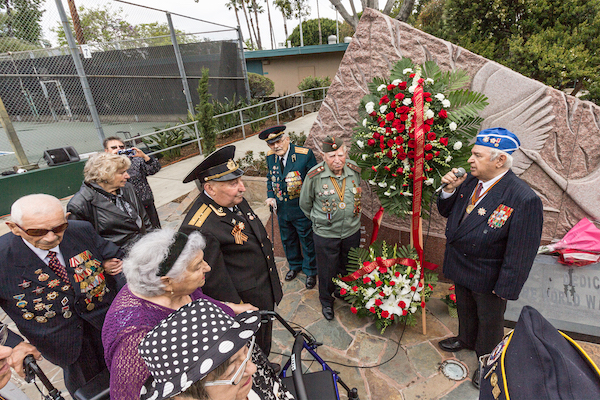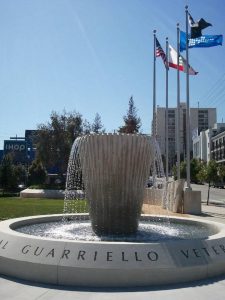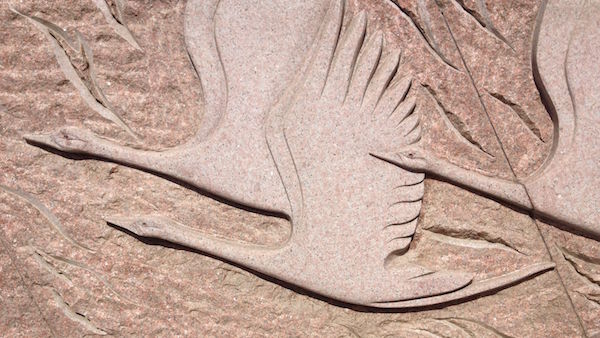
The only memorial on American soil that honors World War II veterans from the former Soviet Union resides in peacenik West Hollywood, where city fathers like to adopt anti-war resolutions and urged Congress to create a Department of Peace and Nonviolence.
The city provided a site at Plummer Park for the Russian Veterans Memorial, erected in 2005 to recognize Red Army soldiers who fought a common enemy. Requested by the city’s sizeable community of Russian-speaking veterans, the monument sparked an international outcry by many who saw it as a tribute to Josef Stalin’s atrocities.
Veterans memorials were tricky business for West Hollywood in the early 2000s when the city went from having none to two within a couple of years. The other monument, known today as the Sal Guarriello Veterans Memorial, is located at Santa Monica Boulevard and Holloway Drive and honors veterans of all U.S. military services and wars.

The Guarriello memorial took 14 years to complete, from concept in 1997 to final dedication in 2011. The capital improvement project, to use City Hall vernacular, took so long because of a slow start in defining scope, schedule and budget.
Each memorial faced different kinds of battles in public and behind the scenes. Those skirmishes did nothing, though, to diminish their success in a city that’s decidedly more artistic than militaristic. Both are used frequently by residents and fully integrated into the community through a range of observances and events.
“I believe there is a difference between honoring the military and honoring veterans. We aren’t looking to be cheerleaders for the Department of Defense,” said Jeffrey Prang, WeHo’s mayor in 2001 when U.S. troops were being put on alert and military reserves activated as the country prepared for its second war with Iraq.
The White Cranes of Plummer Park
“It’s like putting up a monument to honor the Nazis,” a Camarillo resident told the Los Angeles Times shortly before the city formally dedicated the Russian Veterans Memorial on May 9, 2005. She was among a small group of protestors who showed up at the ceremony with signs and wearing black armbands.
“If you dedicate a monument on U.S. soil to a military that caused the death of millions, then you’re honoring the wrong people,” noted another protestor as a group of Russian-speaking immigrants from all parts of the former Soviet Union began gathering for the dedication.
An internet campaign featured a petition addressed to state and federal officials opposing the Russian Veterans Memorial. The petition garnered more than 1,500 signatures from residents in 32 states and about 12 foreign countries, among them Poland, France and New Zealand.
For his part, Prang couldn’t understand why people were unable to separate soldiers from the state they served. “This is a monument for and about American residents,” he said. “It pays tribute to those veterans who fought during the war, who then came to the United States and became part of this community. Remember, these folks were just soldiers.”
When it was dedicated in 2005, city officials claimed that the Russian Veterans Memorial was the first such tribute in the U.S. to the veterans of a foreign army. An inscription on the seven-ton block of red granite reads, “Dedicated in memory of and in tribute to the World War II veterans from the former Soviet Union.”
Only one other such monument has been erected in a country where the Red Army never set foot, according to historian Mischa Gabowitsch, who specializes in Soviet war memorials. In 2012, a national monument commemorating the Soviets’ Eastern Front victory over Nazi Germany was dedicated in Netany, Israel.
The Plummer Park monument cost about $100,000, funded through private and business donations, Prang told reporters. Most of the cost was paid by the Los Angeles Association of Veterans of World War II, a group of Russian-speaking veterans in West Hollywood and the Los Angeles area. The organization lobbied for the memorial for eight years before it was erected.
West Hollywood, in addition to providing a site for the memorial, allocated $25,000 to construct its foundation. The city pays annual maintenance and security costs, as well as maintaining the organization’s archival material. Businesses including Hollywood Forever Cemetery provided in-kind services.
The Russian veterans’ L.A. organization had 160 members who had fought in WWII as of February 2015, according to a City Council staff report. Prang estimated that the city’s population of 38,000 in 2005 was comprised of about 6,000 Russian-speakers, most of whom made Plummer Park the heart of their social and cultural activities. By 2013, the number of Russian-speaking residents had declined to nearly 4,000, the city’s website states.
Mikhail Naruzetskiy, a sculptor from the Ukraine who came to West Hollywood in 1993, designed the triangle-shaped monument that rises to a height of nearly nine feet. It features the engravings of three white cranes taking wing and the opening verse of a poem by Soviet poet Rasul Gamzatov titled “Cranes.” The poem imagines that the spirits of dead soldiers rise from the battlefield as white cranes.
Russian-speakers in West Hollywood observe Victory in Europe Day every May at the memorial. The day marks another anniversary of the defeat of the German army in Europe and serves as a remembrance of an estimated 50 million people who lost their lives during World War II.
Plummer Park also is home to another memorial that commemorates Russian losses during World War II. The Babi Yar Memorial remembers those who lost their lives at a ravine by the same name that was turned into a massive grave for Holocaust victims. The ravine is near Kiev, capital of the Ukraine.

Sal Guarriello Veterans Memorial – The Quest for Cash
For four years running, the One Billion Rising has kicked off its annual Los Angeles campaigns to end violence against women at the park-like Sal Guarriello Veterans Memorial. The successful events have drawn actress Jane Fonda and actor Dylan McDermott, among other celebrities, showing the memorial’s popularity among community groups of all sizes and causes.
Guarriello was a City Council member for 19 years, a former U.S. Army medic and Purple Heart recipient. He got the idea for a veterans memorial after a friend took a group of high school students to France in the mid-1990s and discovered that the teenagers knew little about World War II. After convincing his City Council colleagues to approve the concept of a memorial in 1997, Guarriello set about raising money.
The memorial was a long time coming – 14 years to be exact. It came together during a period when the city wasn’t waist deep in cash like it is today. The memorial’s contemplative nature about sacrifice, created by landscape architects Douglas and Regula Campbell, belies the funding battles waged over time to finally complete the project in 2011.
Almost anyone who attended a City Council meeting during that period isn’t likely to forget a pledge made by the popular Guarriello. He told audiences several times over that “not one cent of taxpayer money was being spent on the funding” of the memorial, according to City Council minutes. The commitment proved to be too bold, too soon.
All totaled, the memorial wound up costing about $900,000, with public funds paying for nearly all of it. Taxpayers’ share of the tab included a $220,000 grant from the California Bond Resources Act of 2002, while private and business donations accounted for at least $100,000. The rest came from city coffers.
How It Happened
In April 2000, the Los Angeles Times noted, “The memorial has come this far with the city’s blessing and lots of community involvement, but a budget was never established. When the price tag of $1.2 million was recently disclosed, “there was a bit of sticker shock,’” (former Mayor) Prang said. “In the early talking stages of the project, he had envisioned a budget of no more than $250,000.”
Nearly all aspects were up for grabs at that point – a site hadn’t even been chosen and higher priorities loomed. That’s when the City Council sent everything back to staff, ordering “a definite plan for how the money will be raised.”
A private fundraising drive fell short of its $200,000 goal by half in 2001, the Los Angeles Times reported. And that was with the help of a lobbying firm, the Afriat Consulting Group of Burbank, retained the year before “for veterans memorial fundraising,” according to City Council minutes.
Headed by Steve Afriat, the firm was plugged into the city’s political establishment. Afriat worked as a campaign consultant or fundraiser at various times for current and former council members including John Heilman, John Duran, Abbe Land, Steve Martin, Prang and Guarriello.
The memorial, unfortunately, even got tangled up in heated local politics over the Sunset Millennium project, as it was called at the time. Today the $300 million hotel, retail and office development under construction along three blocks of Sunset Boulevard at La Cienega Boulevard is known as Sunset / La Cienega.
Mark Siffin, managing partner of the developer, Apollo Real Estate Advisors, donated $21,000 to the memorial’s construction fund just hours before the City Council voted in August 2001 on whether he could install lucrative, high-rise billboards on top of the project.
Guarriello cast the deciding vote that approved Siffin’s billboards. Opponents cried foul, but Guarriello contended that the developer’s donation did not influence how he voted. Guarriello claimed he had been in favor of the billboards all along, a position opponents took issue with while calling for a stronger code of conduct for elected officials. His cohorts on the City Council supported Guarriello.
The kerfuffle over Siffin’s memorial donation slowly fizzled out over next few months – mainly because the City Council rescinded its vote approving the billboards in early 2002. Members said they lost confidence in Siffin for several reasons spelled out in embarrassing newspaper stories. Unsavory activities by Siffin included his allegedly buying the support of Sunset Millennium’s neighbors with hundreds of thousands of dollars. Siffin called the transactions “mutual support and benefits agreements.”
Siffin also moved to replace Sunset Millennium’s 350-room hotel with housing without telling the city, council members said at the time. By April 2002, Apollo had replaced Siffin as managing director and others in the firm took control of the development.
The Final Countdown
Construction finally began in 2003 on the first phase of the Holloway Park and Veterans Memorial, as it was called originally, when the city awarded a construction contract for $423,470 (plus $40,000 in contingencies), which didn’t include a much desired water feature or large fountain.
The last significant component put in place was the water feature, which was built in 2011, eight years after the first phase was dedicated. That’s when the city awarded a construction contract for $246,000 (plus $37,000 in contingencies). The estimated cost of the large cup-like fountain varied considerably over the years, beginning with $80,000 allocated for it in the FY 2006-07 city budget.
That estimate didn’t hold water very long, as the FY 2008-09 city budget set aside more than three times that amount, or $250,000. By the time the FY 2010-11 budget rolled around, the cost dropped slightly to $220,000. No explanation was given for why the water feature rose in price to that extent.
With several redesigns and change orders along the way as council members altered the scope and nature of the memorial, architect fees rose accordingly. The firm of Campbell and Campbell was paid about $190,000 for its work on the project, which began no later than 2000 and continued until project completion in 2011, according to budget documents and City Council minutes.
The City Council renamed the memorial in Guarriello’s honor five months after he died in April 2009. The decision flew in the face of the council’s own “memorial naming policy” that had been in place at least since 2000. At that time, it required a two-year waiting period after a person’s death to name anything in his or her honor. The policy was amended in 2004 to specify a more stringent five-year waiting period.
“Memorials in honor of deceased persons shall not take place until five years after their deaths,” states the resolution (No. 04-3135) adopted in 2004, further expanding the policy. “It is felt appropriate to establish such a waiting period to ensure the test of time and that decisions shall not be made on an emotional basis following a person’s death.”
City Council minutes note that elected officials were acting on the recommendation of the Public Facilities Commission, but don’t provide any insight about why the council abrogated its own memorial naming policy nonetheless.
Steve Martin, a former city councilman through at least the first six years of the memorial’s development, waxed philosophical in 2010 about the time and money the project absorbed when he wrote: “Our award-winning memorial is without a doubt the most impressive monument to veterans built west of the Mississippi in the last 50 years. Scores of cities our size and larger have built veteran’s memorials since the end of the Civil War but West Hollywood’s certainly outshines any modern monument in Southern California. We have every reason to be proud of its design and what it celebrates.”

Wow, that was a nice, touching and respectful tribute to Sal. Thank you. As he would want it, the Sal Guariello Veterans Memorial is all-inclusive. One City – One Pride. Such an inspirational and moving tribute @Gloria Vassy. Thank you.
I miss Sal.
Sal Guariello spent so many years trying to get this memorial built. Being WW2 vet, meant the world to him He was a Medic in the army and as afore said, received the Purple Heart. BTW, he NEVER would have given it to Trump. That aside, He worked tirelessly on the project and it finally came about. The Council t the time, wasn’t in favor of it. So Sal decided to raise the money himself, and then was accused of receiving an underhanded donation. This Memorial, was to honor All Veterans, of All wars. He was the one responsible for… Read more »
The beautiful and poetic Cranes Memorial at Plummer Park says it all, the rest was superfluous. Cranes carrying the souls of the dead is a very important piece of symbolism in many cultures and was beautifully depicted in an award winning Russian film, The Cranes Are Flying by Mikhail Kalatozov, a MUST see.
General George Patton, who once claimed that he loved the business of war more than life, was set in a scene from the movie, Patton, on an ancient Roman battlefield and said, Two thousand years ago – I was here.” Thee are memorials to wars and memorials to people. I like to think our two memorials help me remember the poor bastards who gave it all, whether they knew why or not. Such is the human drama. Today, when I am asked if I “served” and my affirmative reply is met with a “thank you”, I can only nod and… Read more »
Whoever wrote this called our city “peacenik”? Did they think this was funny or sarcastic? Yes we pass resolutions for peace, love, tolerance, acceptance and peace. Why is this a target of ridicule? As a Veteran, I am happy our city resolves to make a better place to live, shop, dance, drink, eat and exist. While we don’t always seem to find a balance between developers’ and residents’ goals, we do maintain a higher level of humanity coexistence that should be valued. And we wants that peacenik view to spread to other cities, states, countries. Just sayin.